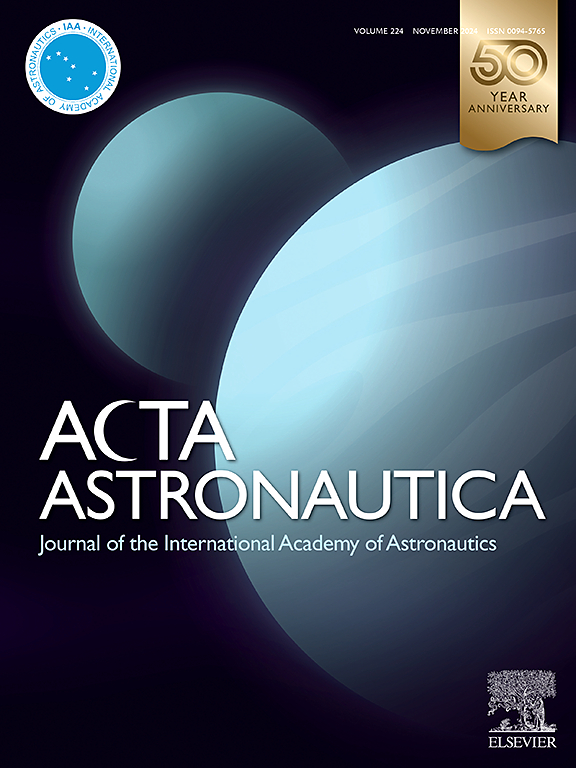确定新兴技术对载人深空飞行任务地球通信依赖性的影响
IF 3.4
2区 物理与天体物理
Q1 ENGINEERING, AEROSPACE
引用次数: 0
摘要
未来的人类深空探险将遇到因距离地球越来越远而带来的独特设计挑战,其中之一是无法与地面支持团队保持近乎不间断的通信。因此,栖息地和乘员将需要更高水平的运行自给自足能力,并通过机载自我意识和决策能力来完成以往需要任务控制人员提供大量支持的功能。这些功能包括任务规划、异常检测、诊断和纠正,以及监测消耗品使用率和系统性能等。可以利用 "智能 "系统和数字双胞胎领域的新兴技术来实现所需的机载功能,从而在与地球通信最少的情况下发挥功能。这项工作提出了效用理论的延伸,以评估基准技术和新兴技术之间在减少地球通信依赖方面的潜力,通过加权属性总和进行评分,并根据未来深空任务的需求和限制进行评估。案例研究是根据美国国家航空航天局空间技术研究所(STRI)正在开发的 "优化探索任务栖息地"(HOME)技术(该项目负责开发和评估实现高度自主深空栖息地的技术)确定的,并与国际空间站上目前使用的基线技术进行比较。美国国家航空航天局(NASA)目前的月球和火星计划提供了名义上的深空任务需求和限制。这些需求和限制又被细分为分辨率更高的属性,用于评估每项新兴技术的运行能力,以及是否能为深空提供潜在可行的解决方案。通过一系列半结构化的主题访谈对这些技术属性进行评分,并与名义上的深空任务限制进行比较。此外,还讨论了技术成熟和集成的其他考虑因素。此处描述和展示的设计分析范例可用于评估其他新兴技术对地球通信的依赖程度,其目的是为未来实现深空栖息地自给自足的研究和开发提供贸易空间方面的考虑。本文章由计算机程序翻译,如有差异,请以英文原文为准。
Characterizing the impact of emergent technologies on earth communications reliance for crewed deep space missions
Future human expeditions into deep space will encounter unique design challenges posed by the increasing distance from Earth, one of which is the inability to maintain near-continuous communication with ground support teams. As a result, the habitat and crew will require a higher level of operational self-sufficiency informed by onboard self-awareness and decision-making capabilities to accomplish functions that have historically involved extensive support from mission control personnel. These include, for example, task planning and anomaly detection, diagnosis and correction, as well as monitoring of consumable usage rates and system performance. Novel emergent technologies in the domain of ‘smart’ systems and digital twins can be employed to enable the onboard capabilities needed to function with minimal Earth communication. However, these technologies are generally low-TRL and difficult to incorporate through traditional systems engineering methods.
This work proposes an extension of utility theory to assess the potential reduction in Earth communication reliance between baseline and emergent technologies, scored through a summation of weighted attributes and evaluated against future deep space mission needs and constraints. Case studies are defined from technology under development in the NASA Habitats Optimized for Missions of Exploration (HOME) Space Technology Research Institute (STRI), a project charged with developing and evaluating technologies to enable highly autonomous deep space habitats, and compared to the current baseline technologies used onboard the International Space Station. Notional deep space mission needs and constraints are informed from current NASA plans for the Moon and Mars. These in turn are broken out into higher resolution attributes that are used to assess the operational capabilities of each emergent technology and whether it offers a potentially viable solution for deep space. These technology attributes are scored through a series of semi-structured subject-matter interviews and compared to notional deep space mission constraints. Additional considerations for technology maturation and integration are also discussed. The design analysis paradigm described and demonstrated here can be adapted to assess the degree to which other emergent technologies rely on Earth-based communication, and is intended to provide trade space considerations for future research and development towards deep space habitat self-sufficiency.
求助全文
通过发布文献求助,成功后即可免费获取论文全文。
去求助
来源期刊

Acta Astronautica
工程技术-工程:宇航
CiteScore
7.20
自引率
22.90%
发文量
599
审稿时长
53 days
期刊介绍:
Acta Astronautica is sponsored by the International Academy of Astronautics. Content is based on original contributions in all fields of basic, engineering, life and social space sciences and of space technology related to:
The peaceful scientific exploration of space,
Its exploitation for human welfare and progress,
Conception, design, development and operation of space-borne and Earth-based systems,
In addition to regular issues, the journal publishes selected proceedings of the annual International Astronautical Congress (IAC), transactions of the IAA and special issues on topics of current interest, such as microgravity, space station technology, geostationary orbits, and space economics. Other subject areas include satellite technology, space transportation and communications, space energy, power and propulsion, astrodynamics, extraterrestrial intelligence and Earth observations.
 求助内容:
求助内容: 应助结果提醒方式:
应助结果提醒方式:


